We got a call from the owner of Buster, a horse we’d helped a three years ago out in Orting. Before we’d met him, he’d had a broken pelvis and the convalescing had left him without enough muscle in his hind end to stand back up after laying down. We had gone out for a standard lift with a tripod and successfully raised him
Because of COVID-19, the state and counties that allow us to respond are more cautious when issuing the emergency numbers we need to respond. Pierce County granted us one, and we were grateful for it as well as the tiny supply of masks our equipment person had the foresight to put in our equipment vehicle a while back so we could be safe.
On site, we found Buster down a steep slope, much improved in the health department, though in a more stressful situation than we’d last seen him in.
The slope he was on was fairly steep, about 70%+, or just steep enough where it was a good idea to have a rope to assist a human with going up or down. About two thirds of the way down the slope there was an area that leveled off a bit, giving us a spot to do some staging.
Buster had originally fallen a little ways and worked his way farther down in his attempts to get up, ending with his back facing downhill and tucked tightly against a group of trees. The trees stabilized his continued movement down the hill and but also presented a challenge for us.
Most times when we are helping out a horse who can’t get up or move we pull them onto a glide, which is a thick sheet of plastic that acts like a flat sled. Once on the glide, we use webbing, ratchet straps, and other equipment to secure them to the glide. Then we pull the glide wherever we need the horse to go.
The problem Buster’s situation is we usually pull the horse onto the glide by setting the glide against its back and pulling the horse onto it. The trees, which were keeping Buster in place, also kept us from being able to get him on the glide. In order to pull him on from the other side, we’d need to pull him up the hill. We decided on putting the glide in front of him, rigging him with a tow strap into a makeshift harness called a Wideman Configuration.
We attached the haul system to the Wideman, and pulled Buster first in a pivot and then up and onto the glide. To keep him from siding back down the glide, we attached him to an anchored rope so we could move the attachment for the haul system to the glide. We also strapped him to the glide at that point.
While part of the team had been working with Buster, another part of the team was setting up rigging above. We considered setting up the tripod as point to redirect the system off of, but ended up going with a very sturdy fir tree. This tree was the same we’d rigged off of the last time we were out and it served us well again.
The haul took place in two parts, thanks to the break in terrain about a third of the way up.
The slope we were on was covered in blackberry brambles. We wanted to minimize both the forces of the pull and the friction from the ground and blackberries as well as try to protect Buster from getting scratched by the blackberry canes, so we used some other sheets of plastic we had as slip sheets for the glide. In the photos, these are the white rectangles.
Once we had him up and landed on the break in terrain, we got a chance to adjust the straps keeping him in. We were able to add some padding and adjust straps to keep his hindquarters more comfortably tied in since the next haul would be longer.
We should take a moment to say we were fortunate to have Dr. Valerie Pflughoeft of Tacoma Equine already on site when we got there. She was great to work with, calm and focused on Buster’s health and kept him sedated the perfect amount to keep the whole process as stress free as possible for him.
The second part of the haul went well. The slip sheets made the process a lot easier and we were lucky to have the family and volunteers we did to manage the load. Bringing a weight up a hill means you are hauling more than just the weight. There are extra forces added in, and we’ve seen them go up significantly during testing we’ve done. For example, a 1200 lb horse can result in a 7000 lb force on the system. For those who are curious about the technical details, we had a 2:1 mechanical advantage at the nose of the glide and a 9:1 on the haul system, giving us a 18:1 mechanical advantage to complete this response.
Once at the top of the haul point, everyone grabbed a rope or tagline and pulled Buster, still on the glide, to a safer spot so we could unstrap him and coax him up.
Dr. Pflughoeft had timed the sedation to be wearing off to coincide with the unstrapping. We pulled the packaging off of Buster and let him rest a little. We tried to get him to make an attempt to stand. We were concerned since he had been laying on the same side he’d landed on for much of the day, so we guessed he might be numb on his down side. We rolled him to the other side. We gave him a bit of a rest and some massages. His owner brought a hay bale so we could prop him up if we could get him sternal so he could breathe better. Right about then, he decided to get up on his own.
He took a few hesitant steps and was able to eventually walk well enough to be taken to his paddock. The Dr. Pflughoeft checked him out and was happy with his health. We sprayed our equipment with a sanitizer, packed up, and debriefed. By the time we left, Buster was busy with his evening meal.
You can read about Buster’s original rescue on the WASART webpage: Buster: Horse Needing a Lift.
![]() View, share, and comment on this story on Facebook.
View, share, and comment on this story on Facebook.
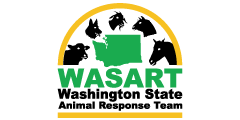
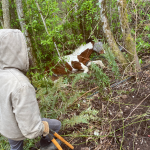
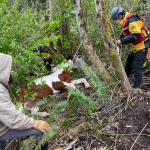
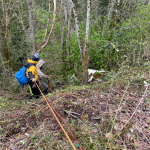
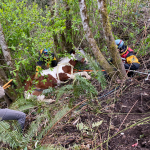
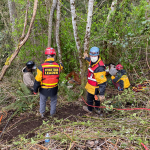
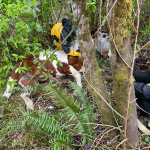
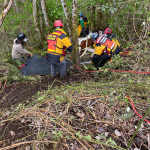
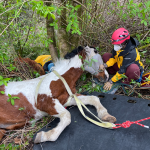
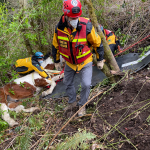
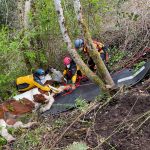
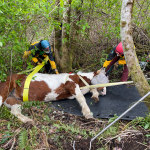
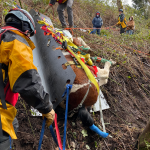
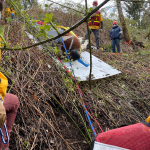
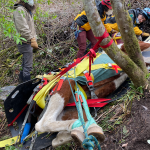
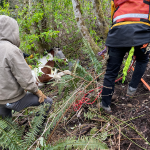
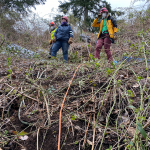
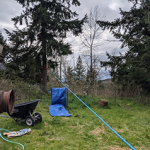
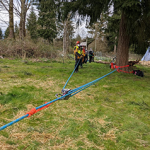
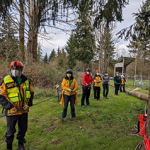
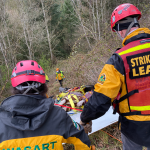
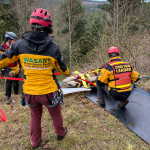
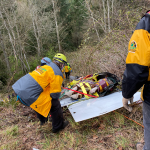
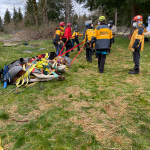
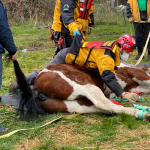
 Bella, Dog Over Cliff at Youngs Creek
Bella, Dog Over Cliff at Youngs Creek